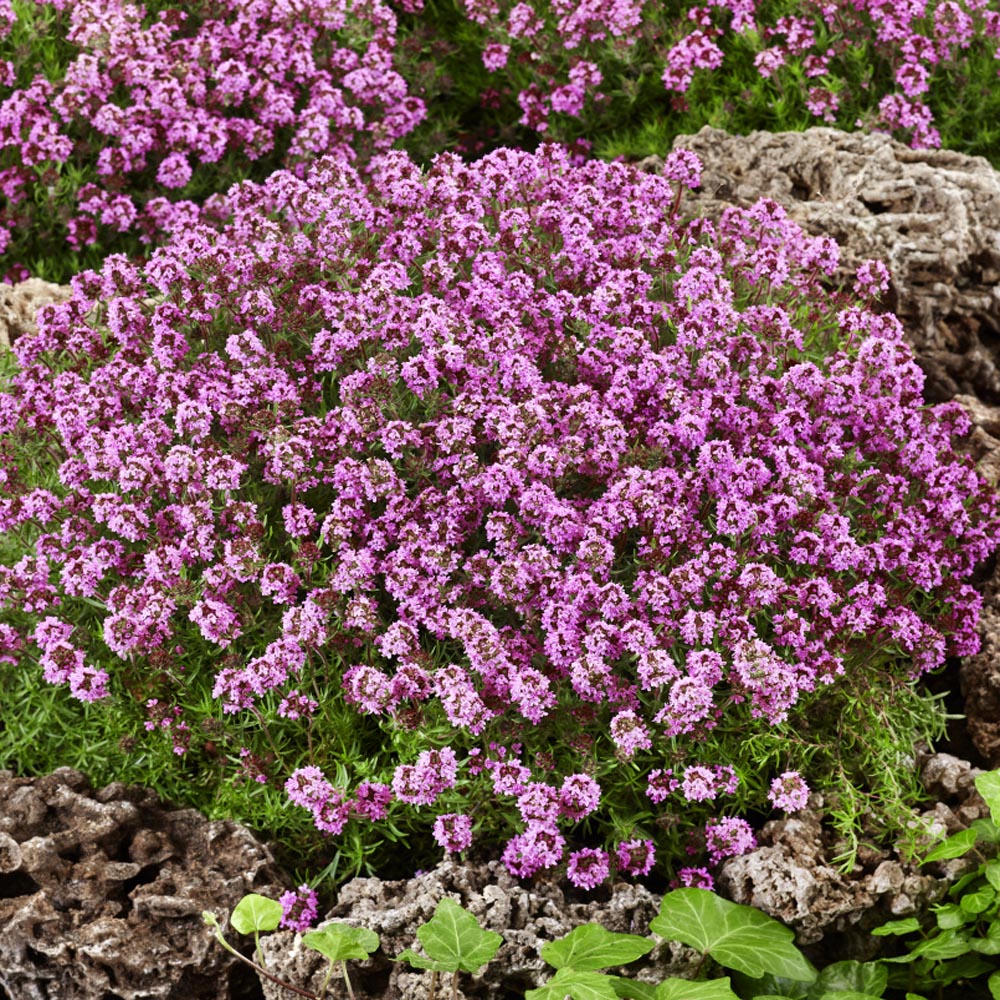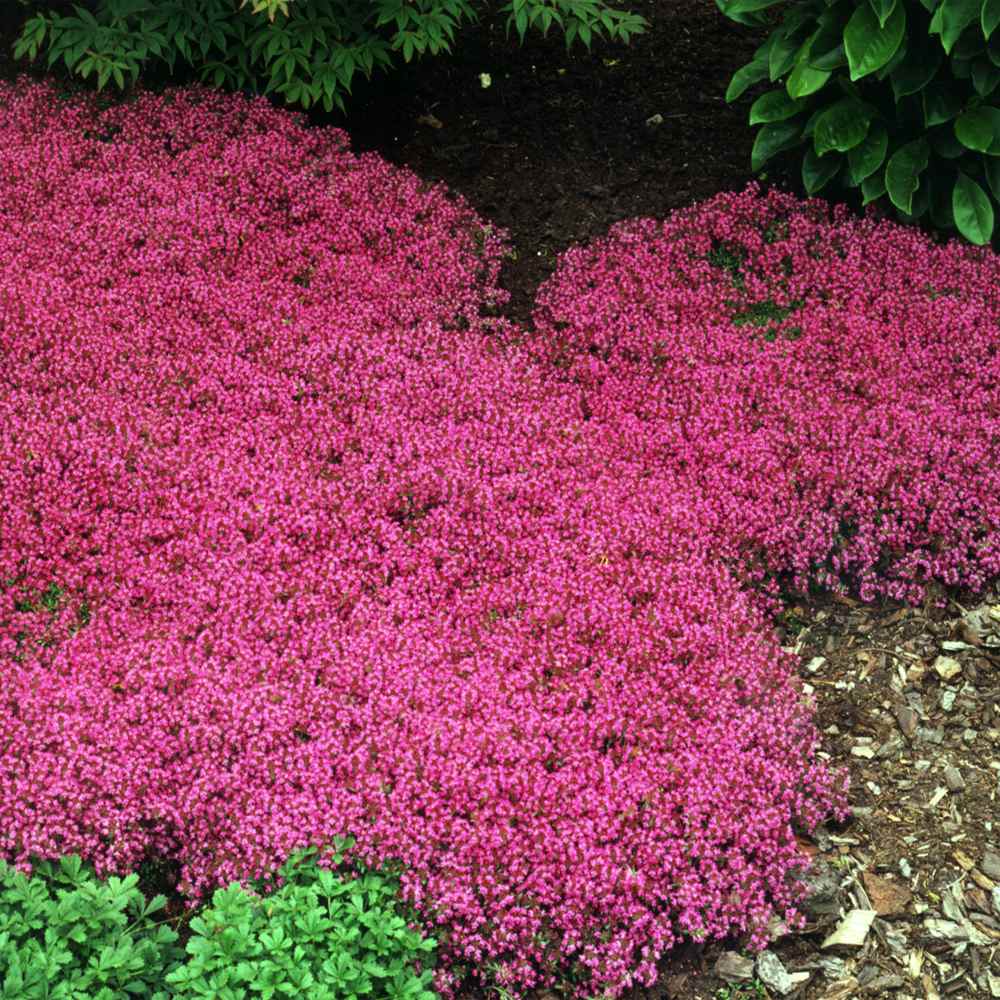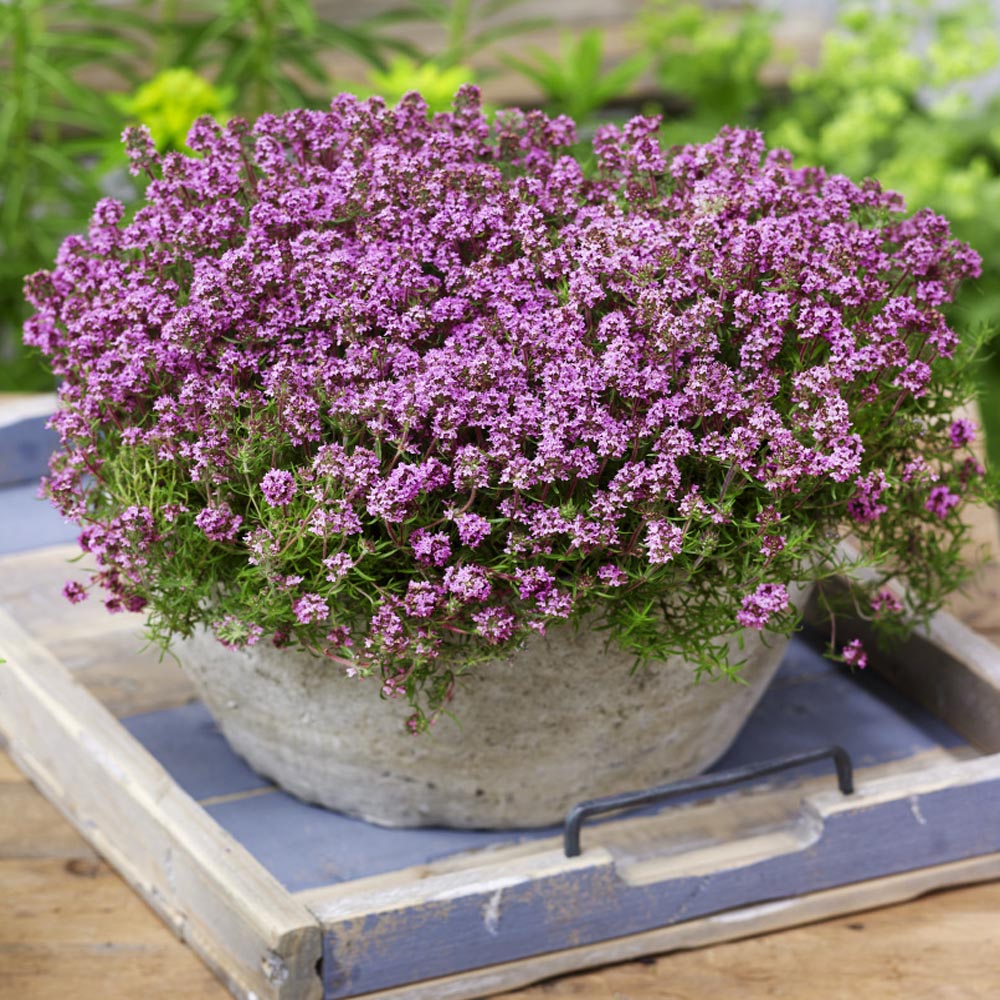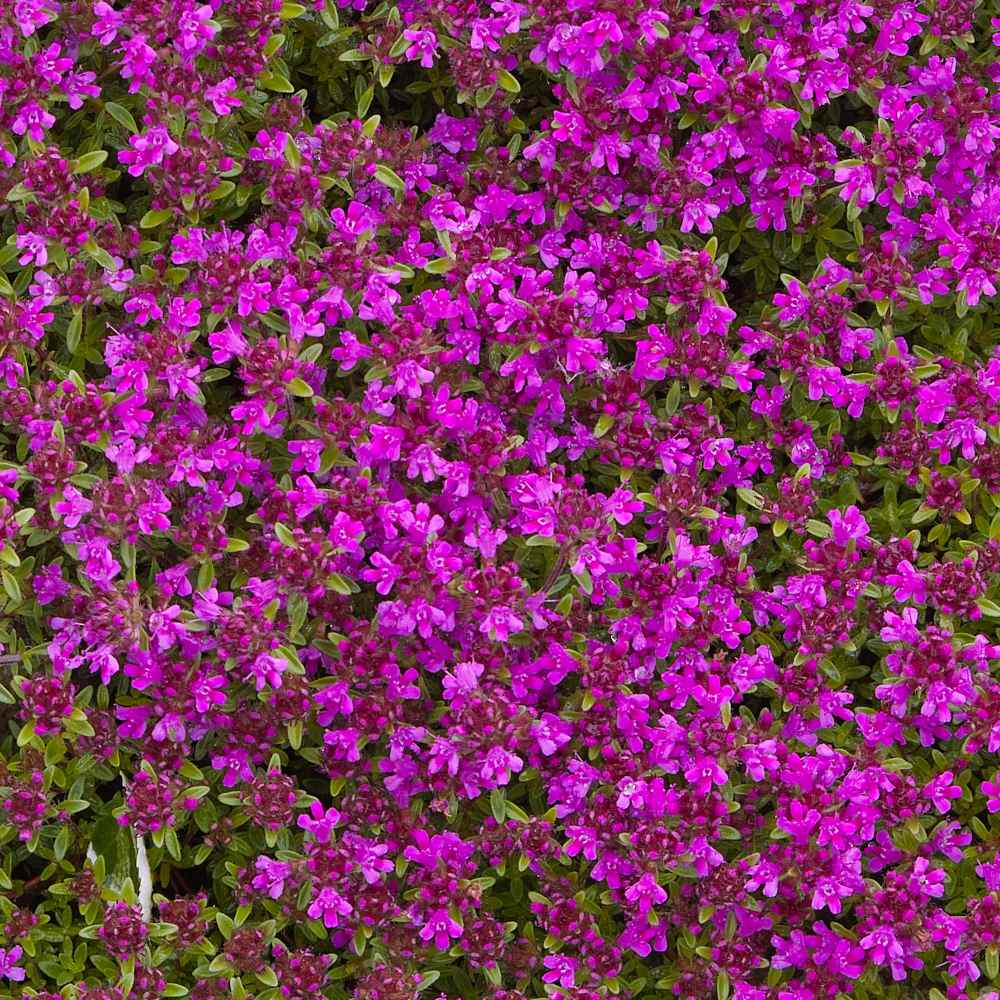Discover the Allure of Creeping Thyme Ground Cover
Creeping thyme (Thymus serpyllum) is a low-growing, spreading ground cover that has been enchanting gardeners for centuries. This charming, fragrant herb is perfect for creating a lush, weed-suppressing carpet in gardens, patios, and walkways. With its tiny, delicate flowers and soft, velvety foliage, creeping thyme is an excellent choice for adding beauty and functionality to outdoor spaces.
One of the most significant advantages of creeping thyme is its ability to attract pollinators, such as bees and butterflies, which are essential for maintaining a healthy ecosystem. Additionally, this ground cover is extremely low-maintenance, requiring only occasional watering and mowing to keep it looking its best. Creeping thyme is also an excellent choice for areas with poor soil, as it can thrive in conditions where other plants might struggle.
When planted as a ground cover, creeping thyme seeds can create a stunning “magic carpet” effect, with its tiny flowers and foliage spreading quickly to form a dense, weed-suppressing mat. This makes it an ideal choice for areas where weeds are a problem, as it can outcompete them for water and nutrients. With its fast-spreading habit and ability to inhibit weeds, creeping thyme is an excellent choice for gardeners looking to create a beautiful, low-maintenance ground cover.
In addition to its beauty and functionality, creeping thyme is also a popular choice for its culinary and medicinal uses. The leaves and flowers of the plant can be used in a variety of dishes, from soups and stews to salads and sauces. Creeping thyme is also known for its antiseptic and antibacterial properties, making it a popular ingredient in herbal remedies.
Whether you’re looking to create a stunning ground cover, attract pollinators, or simply add some beauty and functionality to your outdoor space, creeping thyme seeds are an excellent choice. With their fast-spreading habit, low-maintenance requirements, and ability to inhibit weeds, it’s no wonder that creeping thyme is a popular choice among gardeners. So why not give it a try and discover the magic of creeping thyme for yourself?
How to Create a Lush Creeping Thyme Lawn
Creating a lush creeping thyme lawn is a straightforward process that requires some planning and preparation. To get started, choose a location that receives full sun to partial shade and has well-draining soil. Creeping thyme prefers slightly acidic to neutral soil pH, ranging from 6.0 to 7.0.
Before sowing creeping thyme seeds, prepare the soil by loosening it to a depth of 8-10 inches. Remove any debris, rocks, or weeds, and mix in a 2-inch layer of compost or well-rotted manure. This will help improve soil fertility and drainage.
Sow creeping thyme seeds in the early spring or fall, about 1-2 inches apart and 1/8 inch deep. Water the soil gently but thoroughly after sowing. Keep the soil consistently moist during the first few weeks after sowing, but avoid overwatering, which can lead to rot and poor germination.
For best results, use high-quality creeping thyme seeds from reputable suppliers like Outsidepride or Seedland. These seeds are specifically bred for their fast-spreading habit and ability to form a dense, weed-suppressing mat.
After sowing, keep the soil consistently moist but not waterlogged. Creeping thyme prefers about 1-2 inches of water per week, either from rainfall or irrigation. Avoid using high-nitrogen fertilizers, which can promote weak and leggy growth. Instead, use a balanced, slow-release fertilizer to promote healthy growth and flowering.
As the creeping thyme seeds germinate and grow, keep the area weed-free by hand-weeding or using a shallow layer of mulch. This will help prevent competition for water and nutrients and promote healthy growth.
With proper care and maintenance, creeping thyme can form a lush, fragrant carpet that will attract pollinators and add beauty to your garden. By following these simple steps, you can create a stunning creeping thyme lawn that will thrive for years to come.
The Magic of Creeping Thyme: Spreads Quickly and Inhibits Weeds
One of the most remarkable characteristics of creeping thyme is its ability to spread quickly and form a dense, weed-suppressing mat. This “creeping thyme magic carpet” effect is due to the plant’s fast-spreading habit, which allows it to cover large areas in a relatively short period. As the plant grows, it forms a thick, impenetrable layer that prevents weeds from germinating and competing for water and nutrients.
This unique characteristic makes creeping thyme an ideal ground cover for areas where weeds are a problem. By suppressing weed growth, creeping thyme reduces the need for herbicides and other weed control methods, making it a more environmentally friendly option. Additionally, the plant’s ability to form a dense mat helps to prevent soil erosion and retain moisture, reducing the need for frequent watering.
Another benefit of creeping thyme’s fast-spreading habit is its ability to fill in gaps and create a seamless, uniform appearance. This makes it an excellent choice for areas where a smooth, even surface is desired, such as walkways, patios, and driveways. By using creeping thyme seeds to create a “magic carpet” effect, gardeners can achieve a beautiful, weed-free surface that requires minimal maintenance.
In addition to its ability to spread quickly and suppress weeds, creeping thyme also has a number of other benefits that make it an ideal ground cover. Its tiny, fragrant flowers attract pollinators and add a touch of color to the garden, while its low-growing habit makes it an excellent choice for areas where a low-maintenance option is desired.
Overall, the unique characteristics of creeping thyme make it an excellent choice for gardeners looking to create a beautiful, weed-free surface. By using creeping thyme seeds to create a “magic carpet” effect, gardeners can achieve a stunning, low-maintenance ground cover that will thrive for years to come.
Creeping Thyme Companion Planting: Enhance Your Garden’s Ecosystem
Creeping thyme is a versatile ground cover that can be used in a variety of companion planting arrangements to enhance the health and beauty of your garden. By pairing creeping thyme with other plants, you can create a thriving ecosystem that attracts beneficial insects, improves soil health, and increases the growth and productivity of nearby plants.
One of the most popular companion plants for creeping thyme is rosemary. This fragrant, drought-tolerant herb is a natural complement to creeping thyme, and the two plants can be used together to create a beautiful, low-maintenance border. Other good companion plants for creeping thyme include lavender, oregano, and marjoram, all of which share similar growing conditions and can benefit from the weed-suppressing properties of creeping thyme.
Creeping thyme can also be used to improve the growth and productivity of nearby plants. For example, planting creeping thyme near vegetables like tomatoes and peppers can help to repel pests and improve soil health. Similarly, planting creeping thyme near flowers like roses and carnations can help to attract beneficial insects and improve the overall appearance of the garden.
In addition to its benefits as a companion plant, creeping thyme can also be used to create a beautiful, fragrant ground cover that attracts pollinators and other beneficial insects. By planting creeping thyme seeds in a container or directly in the ground, you can create a stunning “magic carpet” effect that will add beauty and interest to your garden.
When selecting companion plants for creeping thyme, it’s essential to choose plants that share similar growing conditions and can benefit from the weed-suppressing properties of creeping thyme. Some good options include:
- Rosemary: A fragrant, drought-tolerant herb that pairs well with creeping thyme.
- Lavender: A low-maintenance, fragrant shrub that can benefit from the weed-suppressing properties of creeping thyme.
- Oregano: A popular herb that can be used in a variety of dishes and can benefit from the pest-repelling properties of creeping thyme.
- Marjoram: A sweet, fragrant herb that pairs well with creeping thyme and can benefit from its weed-suppressing properties.
By using creeping thyme in companion planting arrangements, you can create a thriving ecosystem that attracts beneficial insects, improves soil health, and increases the growth and productivity of nearby plants.
Creeping Thyme Seeds vs. Plants: Which is Best for Your Garden?
When it comes to growing creeping thyme, gardeners have two options: planting seeds or established plants. Both methods have their advantages and disadvantages, and the best choice for your garden depends on several factors, including cost, establishment time, and soil preparation.
Planting creeping thyme seeds is a cost-effective option that allows for greater control over the growing conditions. Seeds can be sown directly in the ground or started indoors and then transplanted outside. This method also allows for a more natural, spreading habit, as the seeds can germinate and grow in a way that mimics the plant’s natural growth pattern.
On the other hand, planting established creeping thyme plants can provide a faster and more immediate result. Established plants have already developed a strong root system and can start producing flowers and foliage right away. This method is also a good option for gardeners who want to create a “magic carpet” effect, as established plants can be spaced closer together to create a dense, weed-suppressing mat.
However, established plants can be more expensive than seeds, and may require more maintenance, such as regular watering and fertilization. Additionally, established plants may not have the same level of adaptability as seeds, and may be more susceptible to pests and diseases.
Ultimately, the choice between creeping thyme seeds and established plants depends on your specific gardening needs and goals. If you’re looking for a cost-effective option that allows for greater control over the growing conditions, seeds may be the best choice. However, if you want a faster and more immediate result, established plants may be the way to go.
Here are some factors to consider when deciding between creeping thyme seeds and established plants:
- Cost: Seeds are generally less expensive than established plants.
- Establishment time: Established plants can provide a faster and more immediate result, while seeds may take longer to germinate and grow.
- Soil preparation: Seeds require a well-prepared soil with good drainage, while established plants can tolerate a wider range of soil conditions.
- Maintenance: Established plants may require more maintenance, such as regular watering and fertilization, while seeds are relatively low-maintenance.
By considering these factors, you can make an informed decision about whether to plant creeping thyme seeds or established plants in your garden.
Tips for Maintaining a Healthy Creeping Thyme Lawn
Maintaining a healthy creeping thyme lawn requires regular care and attention. Here are some tips to help you keep your creeping thyme lawn looking its best:
Mowing: Creeping thyme lawns require regular mowing to keep them looking neat and tidy. Use a lawn mower with a high blade setting to avoid damaging the plants. Mow your creeping thyme lawn every 2-3 weeks during the growing season.
Fertilizing: Creeping thyme lawns require minimal fertilization. However, if you want to promote healthy growth and flowering, you can apply a balanced fertilizer in the spring and summer months. Avoid over-fertilizing, as this can damage the plants.
Pest Management: Creeping thyme lawns are generally pest-free, but they can be susceptible to pests like aphids and whiteflies. Use neem oil or insecticidal soap to control infestations.
Watering: Creeping thyme lawns require minimal watering. However, during periods of drought, you may need to water your lawn regularly. Water your creeping thyme lawn deeply once or twice a week, depending on weather conditions.
Pruning: Creeping thyme lawns require regular pruning to keep them looking neat and tidy. Use pruning shears to trim back long stems and promote new growth.
Soil Care: Creeping thyme lawns prefer well-draining soil that is rich in organic matter. Add compost or well-rotted manure to your soil to improve its fertility and drainage.
By following these tips, you can keep your creeping thyme lawn healthy and thriving. Remember to be patient, as creeping thyme lawns take time to establish and mature.
Some additional tips to keep in mind:
- Avoid walking on your creeping thyme lawn, as this can damage the plants and create bare spots.
- Use a lawn aerator to improve soil drainage and reduce soil compaction.
- Apply a layer of mulch to your creeping thyme lawn to retain moisture and suppress weeds.
By following these tips and maintaining regular care and attention, you can enjoy a beautiful and fragrant creeping thyme lawn for years to come.
Creeping Thyme in Containers: A Beautiful and Fragrant Addition
Creeping thyme is a versatile ground cover that can be grown in containers, adding a beautiful and fragrant touch to patios, balconies, and other small spaces. This low-maintenance option is perfect for busy gardeners who want to enjoy the benefits of creeping thyme without the need for a large garden.
When growing creeping thyme in containers, choose a pot that is at least 6-8 inches deep to allow for good root growth. Use a well-draining potting mix and water regularly, but avoid overwatering, which can lead to root rot.
Creeping thyme can be used as a spiller plant in containers, cascading over the edges of the pot and creating a beautiful, fragrant display. It can also be used as a filler plant, adding a lush, green texture to the container.
One of the benefits of growing creeping thyme in containers is its ability to attract pollinators, such as bees and butterflies. This makes it a great option for gardeners who want to create a pollinator-friendly garden, even in small spaces.
Creeping thyme is also a low-maintenance option for containers, requiring minimal care and attention. It can thrive in a variety of lighting conditions, from full sun to partial shade, and can tolerate a range of temperatures.
Some tips for growing creeping thyme in containers include:
- Choose a container that is at least 6-8 inches deep to allow for good root growth.
- Use a well-draining potting mix to prevent waterlogged soil.
- Water regularly, but avoid overwatering, which can lead to root rot.
- Fertilize lightly, as creeping thyme does not require a lot of nutrients.
- Prune regularly to keep the plant looking its best and to encourage new growth.
By growing creeping thyme in containers, gardeners can enjoy the beauty and fragrance of this enchanting ground cover, even in small spaces. Whether used as a spiller plant or a filler plant, creeping thyme is a great option for adding a touch of magic to your garden.
Conclusion: Why Creeping Thyme Seeds are a Must-Have for Gardeners
Creeping thyme seeds are a must-have for gardeners who want to create a beautiful, fragrant, and low-maintenance ground cover. With its fast-spreading habit, ability to suppress weeds, and attractive flowers, creeping thyme is an ideal choice for gardeners of all levels.
Whether you’re looking to create a lush, green lawn, a fragrant addition to your patio, or a low-maintenance option for busy gardeners, creeping thyme seeds are the perfect choice. With their ability to thrive in a variety of conditions, creeping thyme seeds can be used in a range of applications, from containers to large gardens.
In addition to their beauty and versatility, creeping thyme seeds also offer a range of benefits for gardeners. They can help to improve soil health, attract beneficial insects, and enhance the growth of nearby plants. They are also a low-maintenance option, requiring minimal care and attention.
Overall, creeping thyme seeds are a must-have for gardeners who want to create a beautiful, fragrant, and low-maintenance ground cover. With their fast-spreading habit, ability to suppress weeds, and attractive flowers, creeping thyme seeds are the perfect choice for gardeners of all levels.
So why not give creeping thyme seeds a try? With their many benefits and uses, they are sure to become a favorite among gardeners. Whether you’re a seasoned gardener or just starting out, creeping thyme seeds are a great choice for creating a beautiful and fragrant ground cover.
Remember, with creeping thyme seeds, you can create a “magic carpet” of fragrance and beauty in your garden. So why wait? Get started today and discover the many benefits of creeping thyme seeds for yourself!







